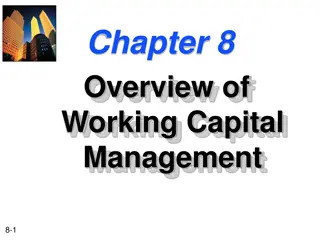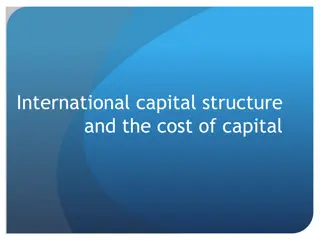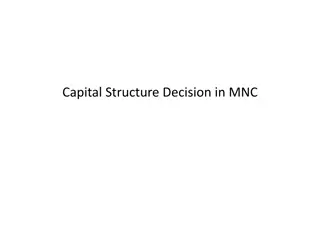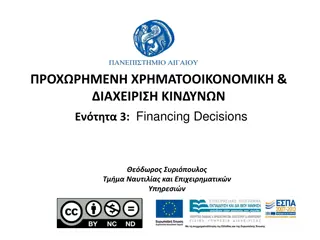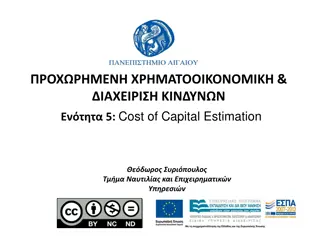Understanding Capital Structure: Concepts, Planning, and Importance
Capital structure is crucial for maximizing shareholders' wealth through an optimal mix of equity and debt. Planning involves balancing risk, returns, and financial requirements, considering factors like return, cost, risk, control, flexibility, and capacity. The value of a firm is linked to earnings and cost of capital, impacting shareholders' wealth. An illustrated income statement demonstrates how capital structure affects profits for equity shareholders.
Download Presentation

Please find below an Image/Link to download the presentation.
The content on the website is provided AS IS for your information and personal use only. It may not be sold, licensed, or shared on other websites without obtaining consent from the author. Download presentation by click this link. If you encounter any issues during the download, it is possible that the publisher has removed the file from their server.
E N D
Presentation Transcript
Capital Structure By Prof Nikita Jain
CapitalStructure Coverage Capital Structure concept Capital Structure planning Concept of Value of a Firm Significance of Cost of Capital (WACC) Capital Structure theories Net Income Net Operating Income Modigliani-Miller TraditionalApproach
CapitalStructure Capital structure can be defined as the mix of owned capital (equity, reserves & surplus) and borrowed capital (debentures, loans from banks, financial institutions) Maximization of shareholders wealth is prime objective of a financial manager. The same may be achieved if an optimal capital structure isdesigned for the company. Planning a capital structure is a highly psychological, complex and qualitative process. It involves balancing the shareholders expectations (risk &returns) and capital requirements of the firm.
Planning the Capital Structure Important Considerations Return:ability to generate maximum returns to the shareholders, i.e. maximize EPS and market price per share. Cost: minimizes the cost of capital (WACC). Debt is cheaper than equity due to tax shield on interest & no benefit on dividends. Risk: insolvency risk associated with high debt component. Control:avoid dilution of management control, hence debt preferred to new equity shares. Flexible: altering capital structure without much costs & delays, to raise funds whenever required. Capacity:ability to generate profits to pay interest and principal.
Value of a Firm directly co-related with the maximization of shareholders wealth. Value of a firm depends upon earnings of a firm and its cost of capital (i.e. WACC). Earnings are a function of investment decisions, operating efficiencies, & WACC is a function of its capital structure. Value of firm is derived by capitalizing the earnings by its cost of capital (WACC). Value of Firm = Earnings / WACC Thus, value of a firm varies due to changes in the earnings of a company or its cost of capital, or both. Capital structure cannot affect the total earnings of a firm (EBIT), but it can affect the residual shareholders earnings.
Particulars Rs. Sales (A) 10,000 (-) Cost of goods sold (B) 4,000 Gross Profit (C = A -B) 6,000 (-) Operating expenses (D) 2,500 An illustration of Income Statement Operating Profit (EBIT) (E = C - D) 3,500 (-) Interest (F) 1,000 EBT (G = E - F) 2,500 (-) Tax @ 30% (H) 750 PAT (I = G -H) 1,750 (-) Preference Dividends (J) 750 Profit for Equity Shareholders (K = I - J) 1,000 No. of Equity Shares (L) 200 Earning per Share (EPS) (K/L) 5
Capital Structure Theories ASSUMPTIONS Firms use only two sources of funds equity & debt. No change in investment decisions of the firm, i.e. no change in total assets. 100 % dividend payout ratio, i.e. no retained earnings. Business risk of firm is not affected by the financing mix. No corporate or personal taxation. Investors expect future profitability of the firm.
Capital Structure Theories A) Net Income Approach (NI) Net Income approach proposes that there is a definite relationship between capitalstructure and valueof the firm. The capital structure of a firm influences its cost of capital (WACC),and thus directlyaffects the valueof the firm. NI approach assumptions o NI approach assumes that a continuous increase in debt does not affect the risk perception ofinvestors. o Cost of debt (Kd) is less than cost of equity (Ke) [i.e. Kd< Ke] o Corporate income taxes do notexist.
Capital Structure Theories As per NI approach, higher use of debt capital will result in reduction of WACC. As a consequence, value of firm will be increased. Valueof firm = Earnings WACC Earnings (EBIT) being constant and WACC is reduced, the valueof afirm willalways increase. Thus, as per NI approach, afirm willhave maximum value at a point where WACC is minimum, i.e. when the firm is almost debt-financed.
Capital Structure Theories As the proportion of debt (Kd) in capital structure increases, the WACC (Ko) reduces. Cost ke, ko ke ko kd kd Debt
Capital Structure Theories B) Net Operating Income (NOI) Net Operating Income (NOI) approach is the exact opposite of the Net Income (NI) approach. As per NOI approach, value of a firm is not dependent upon its capital structure. Assumptions o WACCis always constant, and it depends on the business risk. o Value of the firm is calculated using the overall cost of capital i.e. the WACConly. o The cost of debt (Kd) isconstant. o Corporate income taxes do notexist.
Capital Structure Theories NOI propositions (i.e. school of thought) The use of higher debt component (borrowing) in the capital structure increases the risk of shareholders. Increase in shareholders risk causes the equity capitalization rate to increase, i.e. higher cost of equity (Ke) A higher cost of equity (Ke) nullifies the advantages gained due to cheaper cost of debt (Kd) In other words, the finance mix is irrelevant and does not affect the value of the firm.
Capital Structure Theories Cost of capital (Ko) is constant. Cost As the proportion of debt increases, (K ) increases. e No effect on total cost of capital (WACC) ke ko kd Debt
Capital Structure Theories C) Modigliani Miller Model (MM) MM approach supports the NOI approach, i.e. the capital (debt-equitymix)has no effect on valueof a firm. structure Further, the MMmodel adds a behavioural justification in favour of the NOI approach (personalleverage) Assumptions o Capital markets are perfect and investors are free to buy, sell, switch between securities. Securities areinfinitely divisible. & o Investors canborrow without restrictions at parwith the firms. o Investors arerational& informed of risk-returnof all securities o No corporate income tax, and no transactioncosts. o 100%dividend payout ratio, i.e. no profitsretention
Capital Structure Theories MM Model proposition o Value of a firm is independent of the capital structure. o Value of firm is equal to the capitalized value of operating income (i.e. EBIT) by the appropriate rate (i.e. WACC). o Value of Firm = Mkt. Value of Equity + Mkt. Value of Debt = Expected EBIT ExpectedWACC
Capital Structure Theories MM Model proposition o As per MM, identical firms (except capital structure) will have the same level of earnings. o As per MM approach, if market values of identical firms are different, arbitrage process will take place. o In this process, investors will switch their securities between identical firms (from levered firms to un-levered firms) and receive the same returns from both firms.
Capital Structure Theories D) Traditional Approach The NI approach and NOI approach hold extreme views on relationship between capital structure, cost of capital and the value of a firm. the Traditional approach ( Intermediate approach ) is a compromise betweenthese two extreme approaches. Traditional approach confirms the existence of an optimal capital structure; where WACC is minimum and value is the maximum. firm is As per this approach, a best possible mix of debt and equity will maximizethe valueof the firm.
Capital Structure Theories The approach works in 3stages 1) Value of the firm increases with an increase in borrowings (since Kd< Ke). As a result, the WACC reduces gradually. This phenomenon isup to acertain point. 2) At the end of this phenomenon, reduction in WACC ceases and it tends to stabilize. Further increase in borrowings will not affect WACCand the valueof firm willalso stagnate. 3) Increase in debt beyond this point increases shareholders risk (financial risk) and hence Ke increases. Kd also rises due to higher debt, WACC increases & value of firm decreases.
Capital Structure Theories Cost of capital (Ko) is reduces initially. Cost ke At a point, it settles But after this point, (Ko) increases, due to increase in the cost of equity. (Ke) ko kd Debt
THANK YOU







